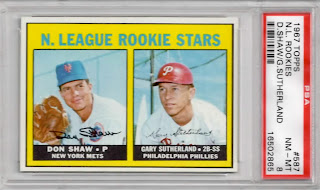
This week on Mets360, I covered the gloriously ludicrous 1972 Topps set in general, and the ludicrously glorious boyhood-photos subset in particular, so I won't trouble you with redundancy.
Rather, this is an entry in “We Flip 'Em So You Don't Have To.” Here's the text on the reverse of the Seaver boyhood-photo card, under the heading “Young Tom Seaver”:
“Tom graduated from Fresno High School in Fresno, California in 1962, he played baseball and basketball and was named to All-City teams in both sports. In 1964 Tom won 11, lost 2, and was named to the All-Valley Conference team. Tom attended the University of Southern California for two years majoring in Public Relations and played varsity baseball. In 1965 he won 10 and lost 2 and was named to the All-California Intercollegiate Baseball Association Second Team. A veteran of Little League and American Legion Baseball, in 1964 Tom helped lead the Alaska Goldpanners of Fairbanks to the state semi-pro title and second place in the National Baseball Congress Tournament at Wichita, Kansas. He won two without a loss in the national tournament and hit a Grand-Slammer, was named to All-Alaska and NBC All-America teams.”
You can find some more info on Seaver's stint with the Goldpanners here.
And yes, I own two of these cards, more out of absentmindedness than affection...



























